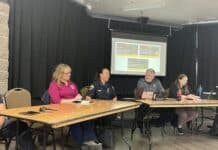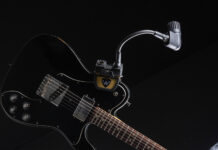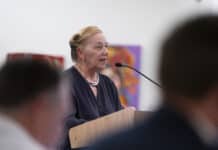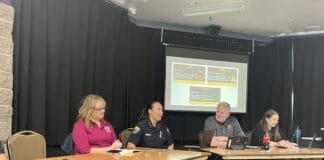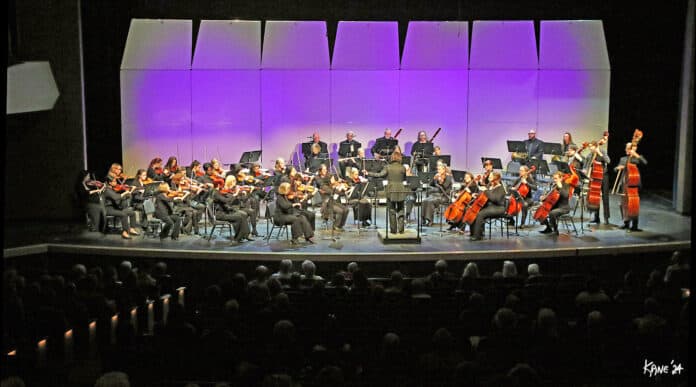
The Sedona Symphony raised the bar yet again with a striking and energetic performance of Franz Joseph Haydn’s Symphony No. 104 “London” during its final regular-season concert at the Sedona Performing Arts Center on Sunday, April 7, as part of a program that included a guest appearance by the Sedona Community Youth Orchestra.
The afternoon’s concert began with Maurice Ravel’s Mother Goose Suite, a light and fun five-movement piece based on fairy tale themes that was written for the children of a couple of the composer’s friends, and one that Artistic Director Janna Hymes recalled performing on the fly at the International Besancon Competition for Young Conductors while a graduate student. After the entry of the flute and high violins, the first two movements flowed together readily, easy as if in sleep, but an uncertain sleep.
The third movement was an excellent demonstration of the orchestra’s increasingly integrated sound, particularly given the odd interjections from the harp, gong and trumpets that Ravel incorporated to add a touch of Chinoiserie, with some impressively smooth playing from the ensemble. In the fourth movement, based on the tale of Beauty and the Beast, the violins started off with a smooth legato before the drone of the contrabassoon stalked out to confront them. Ravel’s piece and its instrumental characterizations were doubtless among Danny Kaye’s inspirations for his memorable “Symphony for Unstrung Tongue” routine in “The Secret Life of Walter Mitty.” For the final movement, most of the orchestra went off and dreamed pillowy dreams while the first violin keened over them, only to disappear as its sparkling, triumphant conclusion built to a confident resolution.
The Symphony’s principal flute, Jeannette Hirasawa Moore, was the solo artist for Sunday’s concert, for which she presented two movements from Georg Philipp Telemann’s “Suite in A Minor for Flute, Strings and Continuo.” The suite is a very formal, restrained work in which Telemann’s pronounced Lutheranism is prominently on display. In effect, the orchestra’s role in the piece was to provide a reassertion of accepted values, such as eternal damnation, which were then confronted by Moore’s flirtatious flute. The strings gave the opening tempo of the “air a l’Italien” segment a somber touch, while Moore took the trills in the solo passages with ease. The contrast between soloist and ensemble was enhanced further in the second selection, marked “rejouissance,” which was quicker-paced but still starchy, against which Moore’s virtuoistic gamboling became almost defiant.
Moore followed this plunge into Baroque formality with a quick transition to the heights of Romantic expressiveness, delivering an instrumental setting of the aria “Kuda, kuda, vi udalilis” from Piotr Ilyich Tchaikovsky’s opera “Eugene Onegin.” Tragic as the themes and language of the aria are, and haunting and evocative as Moore’s performance of it was, it was nevertheless a lighter piece than the Telemann, even gay in places. In these lighter moments, the flute and the strings exhibited a delicious fusion with moments of profound harmony.
After Intermission
The SCYO’s players joined the Symphony after intermission to present Gabriel Faure’s “Pavane in F Sharp Minor,” a simple and dreamy, almost hothouse, work. They had already improved their playing from the previous week’s rehearsal, and succeeding in carrying the pizzicato opening off nicely. What was especially noticeable about their participation, however, was the way in which the addition of a number of extra string players, even if not of professional caliber, enriched the Symphony’s sound. Minor imperfections disappeared in stronger harmonies and a fuller tone for the violin sections — a result that has profound implications when considering the future of community involvement in music in Sedona.
SCYO co-director Courtney Yeates, who plays cello in the Symphony, also took the opportunity to praise Hymes for her ability to motivate musicians with “this winning combination of inspiration and fear.”
Symphony No. 104 ‘London’
Following the Pavane, the Symphony turned its attention to the climax of the concert and the season alike, Haydn’s final and most significant symphonic work. There is perhaps no single composition that straddles both the Classical and Romantic periods of Western music to the same degree that this symphony does, and it is accordingly a challenge to perform for both musicians and conductor. For a conductor, the No. 104 offers a choice of interpretations: Should it be played more like Mozart or more like Beethoven? For the musicians, the work presents them with highly subtle string passages to negotiate that can potentially go awry even in the hands of the best orchestras in the world.
The Sedona Symphony took the challenge and blew it away — literally, given the power of the brass in the finale. The work of the past year had obviously paid off in their handling of the exacting transitions in the opening adagio, and there was none of the orchestra’s previous tendency to drag the strings in slow passages as they moved to the allegro. Though trained by Leonard Bernstein, Hymes eschewed his almost pointillistic approach to Haydn, instead opting for a rich, Romantic sound that emphasized the symphony’s legato aspects and its Beethoven-foreshadowing qualities.
The first movement of this symphony can be compared to a grand entry into an English country estate “on a sunny Tuesday afternoon in June,” as Roger de Bris might say, flags flying, trumpets exclaiming, hallways of warm wood opening away in the distance.
By contrast, the second movement was more like an easy, elegant stroll in the formal gardens behind the house, although even in this portion, the mood alternated between serious and playful, a hint of the afternoon’s party yet to come.
The third movement rocked onto the scene by intensifying this feeling to suggest that the guests were moving to the luncheon stage of the proceedings, with glasses of punch going round. The Symphony found the sound balance here to be slightly tricky at first, but had it fixed by the time they got to the first repeat.
The fourth movement, marked spiritoso, was simply pure party, fast and exuberant with a great punch from the horns. The timpani were strangely subdued here, without the searing crispness that the movement permits, but the force of the rest of the ensemble made up for it. Hymes’ other interpretive choices were spot-on, with excellent tempi and thorough attention to dynamics. Vigorous and wild, full of fire and depth tightly controlled, the Symphony’s rendition of one of Haydn’s masterpieces embodied that contradiction of spontaneity and structure at the heart of the Romantic era that was about to burst on the scene at the time the work was written. It also highlighted the Symphony’s potential to become a superb Haydn orchestra, given its similarity to the composer’s own ensembles.
Farewell and Hail
During intermission, the Symphony board of trustees presented outgoing board president Sue Buffum with flowers and thanks for her services to the orchestra over the past six years.
“Because our bylaws have established term limits for all board members, we have to let you leave,” Symphony Treasurer John Martinez told Buffum. However, he added, they expect her to stay involved, because “we all know where you live,” and promised to carry on her legacy.
Given Buffum’s retirement and the Symphony’s increasing transition to a professional ensemble, the Symphony has also hired its first executive director, Hayfa Marengo, to manage day-to-day operations.
Raising the Curtain
In addition, the April 7 concert was the occasion for the Symphony’s announcement of its upcoming programming for the 2024-25 season. Highlights will include bassist and composer Xavier Foley performing his Soul Bass Concerto; a guest appearance by cellist Nick Canellakis, who is also artistic director of Chamber Music Sedona; a surviving opera overture by the 18th-century violin virtuoso the Chevalier de Saint-George, whose life was recently the subject of a terribly underwhelming film; and piano selections from Scott Joplin and Florence Price.
The Symphony’s final concert of the season will take place on Saturday, April 27, with a guest performance by American Indian flutist R. Carlos Nakai.



